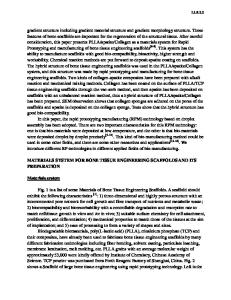Customization of mechanical properties and porosity of bone tissue scaffold materials via Layer-by-Layer assembly of pol
- PDF / 249,766 Bytes
- 6 Pages / 432 x 648 pts Page_size
- 13 Downloads / 220 Views
Customization of mechanical properties and porosity of bone tissue scaffold materials via Layer-by-Layer assembly of polymer-nanocomposite coatings. Ziminska M.1, Dunne, N. 1 and Hamilton A.1 1
School of Mechanical & Aerospace Engineering, Queen’s University Belfast, Northern Ireland
ABSTRACT The aim of this preliminary study was to adapt Layer-by-Layer (LbL) assembly to fabricate nanocomposite coatings onto open-cell porous structures, enabling customization of mechanical properties and porosity to obtain materials suitable for bone tissue scaffold applications. LbL assembly is a well-established method for fabricating multilayer films with nanometre scale precision over thickness that is based on electrostatic attractions and involves the adsorption of oppositely charged electrolytes onto a substrate. Using LbL assembly, polymer-nanoclay composite coatings were deposited onto open-cell foam substrates. The elastic modulus of coated specimens in compression was improved from 0.078 MPa to 1.736 MPa. The results suggest that polymer-nanoclay coatings deposited via LbL assembly have the potential to improve mechanical properties of porous substrates and fabricate materials with mechanical properties comparable to that of a cancellous bone tissue upon deposition of a sufficient number of multilayers. INTRODUCTION Sufficient mechanical properties and a highly porous architecture are crucial characteristics for functional bone tissue scaffold designs. Scaffolds have a load-bearing function and are often exposed to high levels of mechanical stress; hence adequate levels of strength and stiffness are a fundamental requirement [1]. The literature has stated that the mechanical properties of a cancellous bone tissue scaffold should have an elastic modulus between 0.05 GPa and 0.5 GPa and compressive strength between 2 – 12 MPa. A high level of interconnected porosity is also required to stimulate bone growth into the scaffold, however high porosity reduces the mechanical properties [2]. A novel solution to this on-going challenge is to deposit a stiff and strong polymernanocomposite coating onto a porous template using Layer-by-Layer (LbL) assembly. LbL assembly is a technique for fabricating thin-films and coatings that is simple, energyefficient, inexpensive, environmentally friendly [3] and can be carried out on a range of substrates [4]. It allows for a high degree of customization of film thickness, as it has been established as one of the most versatile means to control film properties and molecular architecture at the nanoscale [3]. LbL deposition typically involves the sequential adsorption of oppositely charged polyelectrolytes onto a substrate, driven by electrostatic attraction, and resulting in a uniform multilayer film [4]. This bottom-up technique enables the formation of films with tailored composition, architecture, and properties, and affords the opportunity to incorporate functional layers and biomolecules. LbL assembly has been implemented using a wide range of constituents including proteins, polymers,
Data Loading...











